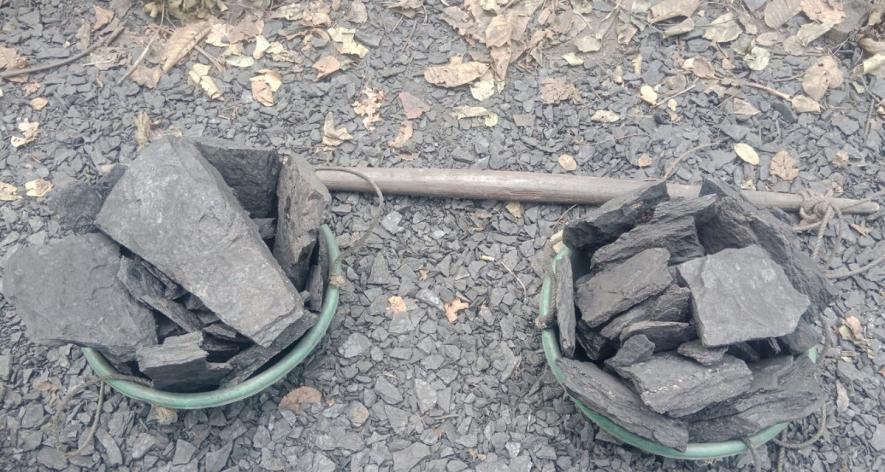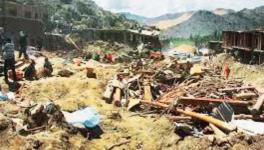Power Cost: How Villages Are Losing Out to Odisha’s Energy Ambitions

Public hearing by a civil society group in Malda village near the Talabira coal project. (Image: Rahul Singh/101Reporters)
Jharsuguda/Sambhalpur, Odisha: Every morning Dilip (35) and his wife, Godavari (32) scavenge their way through the loose earth of the defunct Talabira-1 coal mine in Odisha’s Khinda village of Sambalpur district, gathering stray lumps of coal to sell.
This is their only source of livelihood.
In the 2000s, Godavari’s parents gave up an acre of land for the mine. They received no compensation or employment. Today, Dilip and Godavari stay with her family in a small home at the edge of the mine, constantly dealing with tremors from frequent blasting and cracks in their walls. “We’ve received no benefits from the company,” she told 101Reporters. “Only damage.”
Godavari and Dilip’s story is far from unique. Across the coal belts of Jharsuguda and Sambalpur districts, thousands of families — once landowners — now live as informal labourers in an expanding industrial zone. As the state pushes for higher domestic coal output and builds thermal plants closer to mines, these communities bear the brunt of a failed energy transition: lost land, unstable jobs, and polluted air.
On the Brink
In 2005, Manbodh Biswal’s (70) two acres of land in Khinda village were acquired for the Talabira-1 project with the promise of rehabilitation and direct or indirect employment.
Two decades later, his son Hiteshwar Biswal, a mechanical engineering diploma holder, earns just Rs 12,000 a month in a job offered by the company operating the mine in the area. “The company doesn’t offer permanent jobs anymore,” Biswal said. “Everything is outsourced.”
Many in Khinda, along with residents of four other revenue villages — Malda, Rampur and Patrapali in Jharsuguda and Talabira in Sambalpur — share similar frustrations.
To understand the stories of these villages, one has to understand the history of the coal project.
The Talabira coal project is owned by Neyveli Lignite Corporation (NLC), a Navratna public sector company. Since April 2020, mining operations have been handled by Talabira (Odisha) Mining Private Limited, a subsidiary of Adani Power, which was awarded the contract by NLC.
The Talabira mining area spans two districts: Jharsuguda and Sambalpur. Of the 1,914.063 hectares of land acquired for the coal project, 1,034.136 hectares — or 54% — is forest land that has been officially diverted for mining by the Forest Department.
A study by the Land Conflict Watch estimates that the project could affect as many as 1,894 families.
Notably, last year, the Centre laid the foundation stone for the Talabira-3 Supercritical Thermal Power Plant, a 2,400 MW project (3 x 800 MW units) being developed by NLC India Limited (NLCIL). The plant will be fed directly by the nearby Talabira-2 and -3 coal blocks, which together hold an estimated 553 million tonnes of coal.
By placing the power plant close to the mines, the government aims to cut coal transport costs and streamline supply.
Ground Zero
“They dump waste into our river, kill our fish, and no one stops them,” Rashminandan Sahu (27) said while pointing at the Bheden River in Odisha’s Malda village of Jharsuguda district.
The sky is often dark and ashy across the river and throughout Jharsuguda — home to an estimated 35 to 40 large industrial units.
Along the Jharsuguda–Sambalpur highway, lined with dozens of factories, roads, trees, plants, and even water bodies, have a blackened hue.
Driving along this stretch, the air hums with the sounds of power plants and sponge iron factories, while a steady stream of trucks continuously haul coal in and out of the nearby mines, a defining feature of the region.

A closed coal mine at Talabira. (Image: Rahul Singh/101Reporters)
This is the ground zero of an energy system that is powering cities far away but is leaving its own people breathing dust, drinking polluted water and waiting in vain for rehabilitation and resettlement benefits.
The villagers complain that over the years, the mining companies have changed their land.
Take, for example, the region’s river ecosystem. In Malda village, the Bheden River now only carries waste from nearby factories, residents allege. They claim that companies like Bhushan Steel and SMC Power Generation Ltd release untreated effluents into the water. “We have complained to the district collector twice, but we have received no response,” Sahu added.
The villagers said that in 2017, an ash pond near the Vedanta Aluminium plant in Katikela village of Jharsuguda district collapsed, spilling toxic fly ash into the Bheden. The river, which eventually drains into the Mahanadi, turned grey, and fish died in large numbers.
In 2019, the National Green Tribunal appointed a court commissioner, PC Mishra, to investigate the incident. His report confirmed that 4.2 million metric tonnes of ash had spilt, damaging 65 acres of farmland and 50 acres of open land.
Separately, every year, trees are chopped down without any environmental clearance. One estimate pegs the loss at over 40,000 trees for roads linked to Talabira’s coal operations.
In Malda, Sahu said around 125 acres of forest have already been destroyed. “When we protest, we’re threatened with police action,” he said, adding that Adivasi families here are still waiting for recognition of their forest rights under the Forest Rights Act. But, instead of getting titles, they’re watching their land disappear.
Sahu explained that the expansion of the Talabira-2 and -3 mines will erase Malda village entirely. “Other villages will lose parts, but ours will be gone,” he said.
Money Trail
Jharsuguda may be a small district, but it sits on staggering mineral wealth. The Ib Valley Coalfield alone holds over 9,300 million tonnes of reserves. Mining activities here, particularly those by Mahanadi Coalfields Limited (MCL), a subsidiary of Coal India, span over 9,255 hectares of land.
The Odisha government earns Rs 550-600 crore annually from coal mining in this district alone.
By law, a portion of that wealth is meant to flow back to affected communities through the District Mineral Foundation. This fund is intended to support basic needs: clean water, education, environmental restoration, health care, and alternative livelihoods in places directly impacted by mining.
Parliamentary records show that Jharsuguda received Rs 200.82 crore in 2022-23, of which Rs 137.47 crore was spent. In 2023-24, Rs 180.35 crore came in, but Rs 222.37 crore was spent, possibly using carry-forward funds. By February 2024-25, the district had received Rs 169.26 crore, but only Rs 59.84 crore had been spent.
The region has 133 registered industrial units contributing to the fund. But despite the scale of this financial input, villagers like Sahu said they see little to no improvement in local infrastructure or services. “Our roads are broken, the air is black with dust, and we don’t have clean drinking water,” he said.
Odisha’s Climate Burden
Odisha makes up just 3.5% of India’s population, but contributes nearly 10% of the country’s total greenhouse gas (GHG) emissions. According to the Odisha GHG Emission Profile Report 2022–23 by iFOREST, the state’s emissions stood at 305.2 million metric tonnes in 2022–23 and are projected to rise to between 493 and 782 million tonnes by 2035–36.
The state holds 24% of India’s coal, 50% of its iron ore, 73% of its bauxite, 54% of its aluminium smelting capacity, and 10% of India’s coal-based thermal power capacity.
Power and steel plants account for 84% of the state’s total GHG emissions, with coal-based thermal power alone contributing 49%.
Odisha’s per capita emissions now stand at 6.9 tonnes of CO2, more than twice the national average of 2.8 tonnes. And while the report doesn’t break down emissions by district, the intensity of mining and industrial activity in Jharsuguda makes it one of the likely epicentres of this climate cost.
Up in Ashes
Satyanarayan Rao, president of the Anchalika Parivesh Suraksha Sangh in Jharsuguda, alleged that there is a critical threat to the Mahanadi River—Odisha’s lifeline—and the Hirakud Dam, a Ramsar wetland site, from unchecked industrial waste dumping, often within the prohibited 500-meter river buffer zone.
In 2024, he petitioned the Rajya Sabha Committee on Petitions, naming multiple polluting industries including Vedanta Aluminium, Aditya Birla, Odisha Power Generation Corporation in Banharpali and others, and accusing them of dumping waste on floodplains, forests, and farmland, devastating local forests and tribal lands.
Following these complaints, the Odisha State Pollution Control Board (OSPCB) fined Vedanta Rs 71 crore for illegally dumping over 711,000 metric tonnes of fly ash across multiple districts. Vedanta has challenged the penalty in court, where the case remains pending.
RN Prusty, Chief Environmental Engineer at the OPCB, acknowledged the challenges of monitoring pollution in the highly industrialised Jharsuguda-Sambalpur region, especially unauthorised dumping at night.
“We regularly take action, issue directives, and impose fines. Since Durga Puja in October 2024, we have seen a decline in violations,” he said.
Challenges
Mining is a crucial pillar of Odisha’s economy, ranking second after agriculture and forestry. According to the state’s 2023–24 Economic Survey, mining contributes around 9.4% to the Gross State Value Added (GSVA) and is growing at about 9%, significantly faster than the 3.5% growth rate of agriculture and forestry, which together account for 20.4% of GSVA.
In response to the growing climate crisis and the need for sustainable development, the Odisha government has set ambitious renewable energy targets. The Odisha Renewable Energy Policy, announced in 2022, aims to install 10 gigawatts (GW) of renewable energy capacity by 2030, positioning the state as a leader in India’s energy transition. This policy also envisions the creation of green jobs and the promotion of just transition strategies to support communities impacted by the shift away from fossil fuels.
Despite these plans, the reality in Jharsuguda remains challenging. As of April 2025, Jharsuguda has zero installed renewable energy capacity. The only renewable project planned is a 50 MW solar plant by Odisha Power Generation Corporation Limited.
Additionally, while renewable energy projects are being approved, including a Rs 3,000 crore investment announced by the Indian Renewable Energy Development Agency (IREDA) in December 2024, fossil fuel investments dwarf these efforts. For example, the Talabira Thermal Power Project, a coal-fired plant in Odisha, alone requires an investment of Rs 27,000 crore.
Rahul Singh is a freelance journalist and a member of 101Reporters, a pan-India network of grassroots reporters.
Get the latest reports & analysis with people's perspective on Protests, movements & deep analytical videos, discussions of the current affairs in your Telegram app. Subscribe to NewsClick's Telegram channel & get Real-Time updates on stories, as they get published on our website.
























